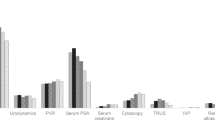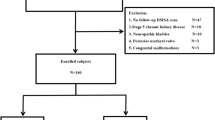Abstract
Background:
Current epidemiological patterns of adverse events of clinical BPH remain unclear. We investigated trends in acute urinary retention (AUR) associated with BPH in a large, population-based cohort.
Methods:
We utilized the California Office of Statewide Health Planning and Development Database to examine 3 724 016 emergency room (ER) visits in California among men aged ⩾ 50 years from 2007 to 2010. Outcomes included AUR for which BPH was the primary diagnosis, AUR for which BPH was a secondary diagnosis and urethral catheterization for AUR. We generated adjusted odds ratios (ORadj) using multivariate logistic regression to determine longitudinal trends.
Results:
A total of 17 023 men presented with a diagnosis of BPH-associated AUR, the unadjusted incidence of which increased from 4.00 per 1000 ER visits in 2007 to 5.23 per 1000 ER visits in 2010 (P<0.001). In adjusted analyses, primary AUR (ORadj=1.25; 95% confidence interval (CI), 1.19–1.32; P<0.001) and secondary AUR (ORadj=1.80; 95% CI, 1.62–2.00; P<0.001) increased 25% and 80%, respectively. Urethral catheterization for primary (ORadj=1.30; 95% CI, 1.22–1.39; P<0.001) and secondary (ORadj=1.82; 95% CI, 1.57–2.11; P<0.001) AUR increased 30% and 82%, respectively. Asian race (P<0.001), Hispanic race (P<0.001) and commercial insurance (P<0.001) were associated with significantly increased risks of AUR and urethral catheterization.
Conclusions:
Between 2007 and 2010, the observed incidence of BPH-associated AUR increased substantially in a large and ethnically diverse male population of the United States.
This is a preview of subscription content, access via your institution
Access options
Subscribe to this journal
Receive 4 print issues and online access
$259.00 per year
only $64.75 per issue
Buy this article
- Purchase on Springer Link
- Instant access to full article PDF
Prices may be subject to local taxes which are calculated during checkout

Similar content being viewed by others
References
Saigal CS, Joyce G . Economic costs of benign prostatic hyperplasia in the private sector. J Urol 2005; 173: 1309–1313.
Wei JT, Calhoun E, Jacobsen SJ . Urologic diseases in America project: benign prostatic hyperplasia. J Urol 2005; 173: 1256–1261.
Engstrom G, Henningsohn L, Steineck G, Leppert J . Self-assessed health, sadness and happiness in relation to the total burden of symptoms from the lower urinary tract. BJU Int 2005; 95: 810–815.
Taylor BC, Wilt TJ, Fink HA, Lambert LC, Marshall LM, Hoffman AR et al. Prevalence, severity, and health correlates of lower urinary tract symptoms among older men: the MrOS study. Urology 2006; 68: 804–809.
Parsons JK, Mougey J, Lambert L, Wilt TJ, Fink HA, Garzotto M et al. Lower urinary tract symptoms increase the risk of falls in older men. BJU Int 2009; 104: 63–68.
Kupelian V, Fitzgerald MP, Kaplan SA, Norgaard JP, Chiu GR, Rosen RC . Association of nocturia and mortality: results from the Third National Health and Nutrition Examination Survey. J Urol 2011; 185: 571–577.
Armitage JN, Sibanda N, Cathcart PJ, Emberton M, van der Meulen JH . Mortality in men admitted to hospital with acute urinary retention: database analysis. BMJ 2007; 335: 1199–1202.
McConnell JD, Roehrborn CG, Bautista OM, Andriole GL Jr, Dixon CM, Kusek JW et al. The long-term effect of doxazosin, finasteride, and combination therapy on the clinical progression of benign prostatic hyperplasia. N Eng J Med 2003; 349: 2387–2398.
Roehrborn CG, Siami P, Barkin J, Damiao R, Major-Walker K, Nandy I et al. The effects of combination therapy with dutasteride and tamsulosin on clinical outcomes in men with symptomatic benign prostatic hyperplasia: 4-year results from the CombAT study. Eur Urol 2010; 57: 123–131.
Parsons JK . Commentary on BPH and public health--have we lost the forest through the trees? J Urol 2008; 179 (5 Suppl): S81.
Stroup SP, Palazzi-Churas K, Kopp RP, Parsons JK . Trends in adverse events of benign prostatic hyperplasia (BPH) in the USA, 1998 to 2008. BJU Int 2012; 109: 84–87.
Cathcart P, van der Meulen J, Armitage J, Emberton M . Incidence of primary and recurrent acute urinary retention between 1998 and 2003 in England. J Urol 2006; 176: 200–204.
Izard J, Nickel JC . Impact of medical therapy on transurethral resection of the prostate: two decades of change. BJU Int 2011; 108: 89–93.
Wei JT, Miner MM, Steers WD, Rosen RC, Seftel AD, Pasta DJ et al. Benign prostatic hyperplasia evaluation and management by urologists and primary care physicians: practice patterns from the observational BPH registry. J Urol 2011; 186: 971–976.
Miner MM . Primary care physician versus urologist: how does their medical management of LUTS associated with BPH differ? Curr Urol Rep 2009; 10: 254–260.
Sung JC, Curtis LH, Schulman KA, Albala DM . Geographic variations in the use of medical and surgical therapies for benign prostatic hyperplasia. J Urol 2006; 175 (3 Pt 1): 1023–1027.
Abelson R, Creswell J, Palmer G . Medicare Bills Rise as Records Turn Electronic, New York Times The New York Times Company: New York, 2012.
Abelson R, Creswell J . U.S. Warning to Hospitals on Medicare Bill Abuses, New York Times. The New York Times Company: New York, 2012.
Stephenson A, Seitz D, Bell CM, Gruneir A, Gershon AS, Austin PC et al. Inhaled anticholinergic drug therapy and the risk of acute urinary retention in chronic obstructive pulmonary disease: a population-based study. Arch Intern Med 2011; 171: 914–920.
Woldrich JM, Palazzi-Churas K, Lakin C, Albo M, Parsons JK . Prostate laser vaporization in men with urinary retention. BJU Int 2011; 108: 395–398.
Kashefi C, Messer K, Barden R, Sexton C, Parsons JK . Incidence and prevention of iatrogenic urethral injuries. J Urol 2008; 179: 2254–2257.
Leuck AM, Wright D, Ellingson L, Kraemer L, Kuskowski MA, Johnson JR . Complications of foley catheters-is infection the greatest risk? J Urol 2012; 187: 1662–1666.
Platz EA, Kawachi I, Rimm EB, Willett WC, Giovannucci E . Race, ethnicity and benign prostatic hyperplasia in the health professionals follow-up study. J Urol 2000; 163: 490–495.
Van Den Eeden SK, Shan J, Jacobsen SJ, Aaronsen D, Haque R, Quinn VP et al. Evaluating racial/ethnic disparities in lower urinary tract symptoms in men. J Urol 2012; 187: 185–189.
Howard DL, Taylor YJ, Ross LE . Differences in lower urinary tract symptoms, treatment and mortality among African-American and white elderly men. J Natl Med Assoc 2008; 100: 1146–1152.
Parsons JK . Modifiable risk factors for benign prostatic hyperplasia and lower urinary tract symptoms: new approaches to old problems. J Urol 2007; 178: 395–401.
Sarma AV, Parsons JK, McVary K, Wei JT . Diabetes and benign prostatic hyperplasia/lower urinary tract symptoms--what do we know? J Urol 2009; 182 (6 Suppl): S32–S37.
Author information
Authors and Affiliations
Corresponding author
Ethics declarations
Competing interests
The authors declare no conflict of interest.
Rights and permissions
About this article
Cite this article
Groves, H., Chang, D., Palazzi, K. et al. The incidence of acute urinary retention secondary to BPH is increasing among California men. Prostate Cancer Prostatic Dis 16, 260–265 (2013). https://doi.org/10.1038/pcan.2013.11
Received:
Revised:
Accepted:
Published:
Issue Date:
DOI: https://doi.org/10.1038/pcan.2013.11
Keywords
This article is cited by
-
Rezūm water vapor therapy for the treatment of patients with urinary retention and permanent catheter dependence secondary to benign prostate hyperplasia: a systematic review of the literature
World Journal of Urology (2022)
-
Holmium laser enucleation of the prostate for very large benign prostatic hyperplasia (≥ 200 cc)
World Journal of Urology (2021)
-
Admission of patients with acute urinary retention leads to a definitive management decision
Irish Journal of Medical Science (1971 -) (2020)
-
Transurethral resection of the prostate provides more favorable clinical outcomes compared with conservative medical treatment in patients with urinary retention caused by benign prostatic obstruction
BMC Geriatrics (2018)
-
Holmium Laser Enucleation of the Prostate in Patients Requiring Anticoagulation
Current Urology Reports (2017)



